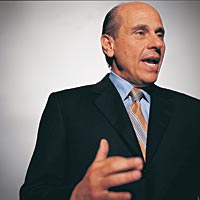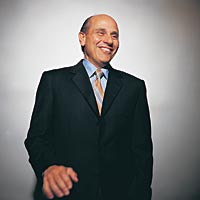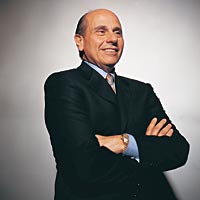|
Photos: Katrina Wittkamp |
|
In pushing the marketing of the sleek new phones, Zander (above) exhorted his people, “Let’s get Motorola cool.” |
Don’t call it a cell phone in front of Ed Zander. Although the chairman and CEO of Motorola is centering his company’s comeback on telecommunications devices bearing catchy names like Razr and Rokr (which sound like “razor” and “rocker” respectively), he doesn’t exactly know what to dub these gadgets. “We refer to it as ‘the device formerly known as the cell phone,'” Zander says, adding that Motorola is constantly asking “bright people to go and define this thing . . . because we don’t know what it is. I think the last thing you’re going to do on this device five years from now is make a phone call.”
What Zander has in mind is to make these onetime cellular telephones everything from a personal entertainment center to a home office, with uses including, he says, “digital TV, movie clips, Yahoo and portal searches, podcasting . . . or ‘I missed Letterman’s monologue last night and want to see it.'”
Obviously, he knows it’s a cell phone, but that dash of hyperbole is typical of the wiry 58-year-old executive. Whether talking with Wall Street analysts or members of the media, Zander peppers his conversations with scrappy comments that can illuminate his turnaround strategy for Motorola-or sometimes backfire. An example: at a recent technology gathering, Zander dismissed Apple Computer’s new iPod Nano by saying “Screw the Nano” and asking who will listen to a device with only 1,000 songs on it. His remarks came despite the fact that Motorola and Apple were longstanding partners and the two companies had lately teamed up to bring out Motorola’s Rokr phone, which uses Apple iTunes software.
Zander says the Nano comment was just good-natured banter at an industry confab (though there’s industry chatter that Zander was pushing back a little because of rumors that Apple will build its own cell phone, which would compete with Motorola brands). But he adds that he’ll work at becoming more circumspect when talking in public, even if it’s not his nature.
“Ed Zander brings a street survival instinct to Motorola,” says Kevin Dede, a wireless-technology analyst with the San Francisco–based Merriman Curhan Ford & Company.
Indeed, after only about two years on the job, Zander has infused the staid Motorola-headquartered in Schaumburg-with the swagger and hustle of Silicon Valley, where he previously worked as president of Sun Microsystems and as a private investor. Not long ago, Motorola cell phones-the company’s chief revenue generator, responsible for 50 percent of sales-were viewed as durable but dull. Now, the sleek Razr, considered on the cutting edge of cell phones in design and function, ranks as a bona fide hit.
The early returns on the Rokr aren’t anywhere near as promising. A cell phone that doubles as an Apple iPod player with 100 songs, the Rokr accounted for just 0.6 percent of third-quarter cell phone sales, or about 250,000 phones, raising questions about Zander’s bet on these many-splendored gadgets. (A Motorola spokeswoman did not return calls seeking comment.) But while the Rokr is not a blockbuster hit and may not entice hard-core gadget heads-tech bloggers are dissing it for not living up to the hype-it is still racking up respectable numbers, says Ben Bollin, senior analyst for FTN Midwest Securities in Cleveland.
In any case, Motorola is pitching hard to teenagers and young adults, who are regularly barraged by the company’s fast-paced and funky commercials. They air on MTV and youth-oriented TV shows carrying the signature tag line “Hello Moto.”
So far, the pitch seems to be paying off. On Razr’s back, Motorola has reversed a slide in its cell phone market share and has resumed making gains against formidable opponents, such as Nokia. Since Zander’s arrival, the company has enjoyed a run of six straight profitable quarters, while the company’s stock has increased by nearly 50 percent to $21 a share. For his part, Zander pulled down an $18.3-million compensation package in 2004.
In the third quarter of 2005, Motorola’s earnings tripled, to $1.75 billion, compared with a year earlier, and earnings per share were two cents higher than Wall Street analysts had expected. Revenues were up 26 percent, fueled by strong sales of Razrs, helping push the company’s global share of the cell phone market to 19 percent from 18 percent.
This turnaround, or “transformation” as Zander prefers to call it, hasn’t come easily. The company is still dumping business units (a step initiated before Zander became CEO) and firing people-the latest round having come in August, when 1,900 employees were given notice. And the transformation could be stopped cold if Motorola’s management again gets blindsided by some new technology wave, as it did in the mid-1990s, when digital-based transmission surpassed the traditional analog services used by Motorola’s cell phones. “Motorola’s become more innovative, flexible, and quicker,” says Bollin of FTN Midwest Securities. “But it’s in a market where change comes quickly.”
Change is nothing new to Zander-or to Motorola. Now a local business icon, the current incarnation of the company dates to 1928, when the brothers Paul and Joseph Galvin bought a small battery eliminator business. A few years later, the Galvin Manufacturing Corporation, as it was then known, started producing car radios under the name Motorola. In 1947, the enterprise officially became Motorola Inc., and in the years to follow it turned into a leading producer of radios, TVs, walkie-talkies, and other electronic communications fare. In 1983, Motorola introduced the first commercial handheld cell phone and then a consumer version that weighed a hefty 28 ounces. The company was already a global communications force with $37.5 billion in revenue in 2000, when it merged with General Instrument Corporation, a marriage that enabled Motorola to expand further into cable, Internet, and high-speed data services.
Throughout most of the company’s existence, the Galvin clan has dominated the executive suite. Paul’s son, Robert Galvin, was at the helm from 1964 to 1986. Robert’s son Christopher held top management slots before being named CEO in January 1997 and chairman in 1999. Halfway through Christopher Galvin’s six-year CEO tenure, Motorola ran into trouble, primarily by losing its position as the world’s leader in cell phones to foreign manufacturers, such as Nokia, Siemens, Sony Ericsson, and Samsung. To make matters worse, the telecommunications sector went through a spurt of investment and overbuilding, only to crash. The boom and bust, along with a tumble in demand for semiconductors-another key Motorola business-helped to trash Motorola’s earnings and stock price.
Christopher Galvin launched a reorganization, laying off many employees, selling assets, and shoring up the balance sheet. The board wanted more change at a faster pace, however, and he resigned under pressure in September 2003. “While I have achieved substantial results, the board and I do not share the same view of the company’s pace, strategy, and progress at this stage of the turnaround,” Galvin said upon leaving. (He declined to comment for this article. At the end of 2003 he held about eight million shares of Motorola stock, according to public filings. After his departure as CEO, Motorola was not required to report his stock ownership, according to a spokesman. The family’s total holdings are probably much greater, with shares held in various trusts.)
Some Motorola insiders point out that by the time Zander arrived in January 2004, the balance sheet had brightened, the Razr was about to launch, and mobile phone orders were picking up. The new CEO ignited some resentment in September 2004 when a technology newsletter quoted him as telling a Silicon Valley group that he had taken one look at Motorola’s operations and decided it was “as bad as anything [he] had seen.”
Today, Zander goes out of his way to give his predecessors their due. “Previous management did a Herculean job,” he says. “A lot of heavy lifting was done prior to me getting here.” He says he has sought out Robert Galvin to “get a historical perspective on the company.” Contact with Christopher Galvin has been limited. “I speak very fondly of the Galvins and what they did with this company,” Zander says. “It’s their company and their name.”
Indeed, Zander questions whether a new CEO should tear apart a functioning company and then completely rebuild it. That’s what Carly Fiorina tried and failed to do when she ran Hewlett-Packard Company before losing her job as CEO this year. (Zander had been on the short list of contenders for the CEO job at H-P that Fiorina won in 1999.) “I’m not lifting up the house and taking out the foundation,” Zander asserts. “Let’s knock a few rooms down and put in some of the things I want-passion, a sense of urgency, accountability, and less bureaucracy.”
To accomplish this, Zander took to the road-which in Motorola’s case means traveling all over the world-to talk to customers and employees in places from Schaumburg to Beijing. His conclusion: folks were happy with the company’s core values and products, but clients were frustrated by slow and uneven service. “Coming from the West Coast, where everything is speed, I told my board I would have everything done in six months. And they laughed,” he says. “And they were right.”
Zander focused on paying down some heavy debt, generating greater cash flow, and finalizing the spinoff of Motorola’s semiconductor business into a publicly traded entity, called Freescale. He’s also installed a more merit-based, pay-for-performance compensation philosophy, where employee raises and bonuses are more closely aligned to their bottom line contributions. In the past, he says, “there was an underlying sense of entitlements.”
Yet Zander sees his most crucial task as raising the company’s collective intensity level and even its fear of the unknown. On the fervor front, Zander points to the accelerated release of the Razr and the Rokr. “I pushed the marketing, saying, ‘Let’s get Motorola cool,'” he explains.
So far, the quest for cool is paying off. Motorola’s share of the global cellular phone business is 19 percent of the handset market, up from about 14 percent two years ago, according to Bollin, the FTN analyst. Nokia is still the leader with 33 percent of the market, but Bollin points out that Motorola is getting a bigger bang for its buck. By souping up phones with different colors and features, Motorola has been able to sell the devices through wireless phone carriers like Cingular and through retailers at a higher price than competitors’. A Razr retails for $199 and the Rokr at $250. Motorola’s average price overall for its phones is $150. “People are looking for those high-end, individualized products,” says Bollin, who notes the Razr is the company workhorse and will likely offset any drag in Rokr sales.
Motorola is also making heavy marketing and sales investments in China, the Far East, and Europe, where mobile phone networks are more advanced and cell phones more pervasive. The average cell phone consumer’s age in those regions is 8 to 18, while in the United States it’s 12 to 20, Zander notes. “The U.S. led the way in personal computer technology,” Zander says. “But in mobile technology, it’s Europe and then the Far East.”
Meanwhile, Zander hopes to gird Motorola for the next great “technology disruption” or another competitive assault not yet foreseen. “Our business gets disrupted every 10, 12 years,” he says. “Nobody saw the PC coming, or the Internet. Now nobody sees [the vast possibilities of] mobile Internet coming. You can be out of business if you’re not careful.”
Periodically, Zander holds what he labels as “whack meetings”-brainstorming sessions with staff and key people where they consider the possibilities that could “whack” Motorola. “What if Wal-Mart gets into our business? What if Cisco did this? Or who buys whom?” he asks. The point of these meetings is to lay down some “big bets” (yet another Zander term) on emerging technologies. In doing so, Motorola is investing nearly $3.5 billion annually in research-which as a percentage of yearly revenues is in line with major technology companies of Motorola’s size-while at the same time hunting for small or mid-sized companies that offer fresh applications, products, and technology. Zander does not completely rule out Motorola’s making a big acquisition, but he prefers smaller, more nimble tech companies that can be more readily absorbed into Motorola’s mammoth system.
How do the research and acquisitions fit with Wall Street’s increasingly short-term craving for higher earnings? “My job is not to press the accelerator down and drive earnings per quarter, but to grow profitably and make sure big bets are funded,” he says.
Zander once confessed jokingly that he “cried” when exposed to the first blast of Chicago cold. The weather shouldn’t have been all that shocking, since he’s got Eastern roots-growing up in Brooklyn and holding an electrical engineering degree from Rensselaer Polytechnic Institute and an MBA from Boston University. He now lives here, but he also owns a home in Carmel, California, with his wife, Mona.
It may seem absurd to wonder already what’s next for Ed Zander. Still, there was a time when corporate chiefs stuck around for an average of ten years; now tenure is less than half that. “We get two, three years,” Zander points out. “[CEO is] a hard job. It needs fresh thinking.” He adds, “In the valley [Silicon Valley], CEOs have been there too long.”
One of these days, if Zander continues to do well, a Silicon Valley company, or IBM or General Electric, might give Motorola’s CEO a jingle to see if he’s interested in running the shop. Who knows? Maybe they’ll even talk on a device formerly known as the cell phone.






